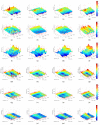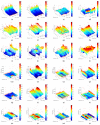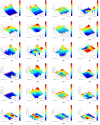Water Quality Sensing and Spatio-Temporal Monitoring Structure with Autocorrelation Kernel Methods
- PMID: 29035333
- PMCID: PMC5677420
- DOI: 10.3390/s17102357
Water Quality Sensing and Spatio-Temporal Monitoring Structure with Autocorrelation Kernel Methods
Abstract
Pollution on water resources is usually analyzed with monitoring campaigns, which consist of programmed sampling, measurement, and recording of the most representative water quality parameters. These campaign measurements yields a non-uniform spatio-temporal sampled data structure to characterize complex dynamics phenomena. In this work, we propose an enhanced statistical interpolation method to provide water quality managers with statistically interpolated representations of spatial-temporal dynamics. Specifically, our proposal makes efficient use of the a priori available information of the quality parameter measurements through Support Vector Regression (SVR) based on Mercer's kernels. The methods are benchmarked against previously proposed methods in three segments of the Machángara River and one segment of the San Pedro River in Ecuador, and their different dynamics are shown by statistically interpolated spatial-temporal maps. The best interpolation performance in terms of mean absolute error was the SVR with Mercer's kernel given by either the Mahalanobis spatial-temporal covariance matrix or by the bivariate estimated autocorrelation function. In particular, the autocorrelation kernel provides with significant improvement of the estimation quality, consistently for all the six water quality variables, which points out the relevance of including a priori knowledge of the problem.
Keywords: Mahalanobis kernel; autocorrelation kernel; pollution measurements; spatio-temporal interpolation; support vector regression; water quality.
Conflict of interest statement
The authors declare no conflict of interest.
Figures







References
-
- Duan W., He B., Nover D., Yang G., Chen W., Meng H., Zou S., Liu C. Water Quality Assessment and Pollution Source Identification of the Eastern Poyang Lake Basin Using Multivariate Statistical Methods. Sustainability. 2016;8:133. doi: 10.3390/su8020133. - DOI
-
- Tebbutt T. Principles of Water Quality Control. 5th ed. Butterworth-Heinemann; Oxford, UK: 1998. pp. 21–22.
-
- Taalohi M., Tabatabaee H. Predicting Bar Dam Water Quality using Neural-Fuzzy Inference System. Indian J. Fundam. Appl. Life Sci. 2014;4:630–636.
-
- Zhuiykov S. Solid-state sensors monitoring parameters of water quality for the next generation of wireless sensor networks. Sens. Actuators B. 2012;161:1–20. doi: 10.1016/j.snb.2011.10.078. - DOI
LinkOut - more resources
Full Text Sources
Other Literature Sources

